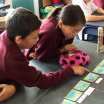Develop expressive language
Expressive language includes any method of communication including speech, New Zealand Sign Language (NZSL) and Augmentative Alternative Communication (AAC).
On this page:
On this page:
Current page section: Develop expressive language
Go to top of current page: Develop expressive language
Go to top of current page: Develop expressive language
Go to top of current page: Develop expressive language
Build knowledge of expressive language components
Build knowledge of expressive language components
Expressive language is the language that we produce or use to convey meaning and messages to others. It includes words and sentences, as well as signs, symbols, gestures and writing.
Expressive language includes:
- phonological patterns, for example, rules for combining and using phonemes, and spelling conventions
- morphemes, for example, how words are formed, and parts of words such as stems, root words, prefixes, and suffixes
- sentence structure
- vocabulary
- social use of language, for example, appropriate conversation skills and writing for a specific audience.
Source: American Speech-Language-Hearing Association (opens in a new tab/window)
Use oral language development steps
Use oral language development steps
Use "Stepping stones in oral language" to identify the next steps for ākonga in the development of English language speech sounds, words and sentences, stories and social interaction. It includes links to bilingual and multilingual pathways.

Enrich language experiences
Enrich language experiences
- Make the most of languages spoken at home as the foundation for language learning.
- Comment on what students are doing. This is less pressure for students than asking questions.
- Model how to say things. For example, if a student wants to join in a game say, “Ben, you could say, ‘Can I join in?’”
- Recast by adding more detailed language, or more correct language. For example, if the students says “pen blue”, recast to “Yes, the pen is blue.”
- Extend on what students say. For example, if an ākonga says, “He’s sad. He lost his bag”, kaiako can add “Yes. He’s sad because he lost his bag.”
- Use specific and descriptive vocabulary in everyday interactions that is matched to the student’s level of language development.
- Repeat new and less familiar vocabulary and provide opportunities for ākonga to use them appropriately and immediately.
- Provide simple student-friendly definitions for new vocabulary.
- Encourage students to monitor and self-correct. For example, “Did he ranned or did he run?”
- Create class visuals, or help ākonga to create personalised visuals, to help them remember new vocabulary and sentence structure conventions.
Source: Adapted from Te Whāriki Online (opens in a new tab/window)
Build oral language confidence and capability
Build oral language confidence and capability
Teachers from Burnside Primary share the findings of their multi-year focus on supporting and improving oral language.
Closed Captions
Adopt expressive language strategies
Adopt expressive language strategies
Adopt strategies to help ākonga to learn new words, use correct grammar, construct sentences and express their needs and ideas.
- Engage in two-way conversations with ākonga.
- Prompt conversations by commenting, describing and narrating rather than direct questioning.
- Encourage all forms of communication including NZSL, use of augmentative and alternative communication (AAC), as well as using gestures, hand signals, objects, pictures and writing.
- Encourage active participation when telling and reading stories and pūrākau.
- Offer a variety of verbal games and waiata.
- Chant and repeat familiar stories, waiata or songs and rhymes.
- Offer sentence starters or choices and prompts to reduce the complexity of responses required of ākonga.
- Wait for ākonga to use sentences, make choices or request items so that they can practise expressing themselves.
Support writing
Support writing
Help students to enjoy writing.
If handwriting is a barrier, add options such as oral storytelling, keyboards and voice typing that allow ākonga to develop deeper writing skills, such as generating language, ordering ideas and paragraph structure.
- Provide inspiration and language through activities, real life experiences, photos, discussions, images and videos.
- Provide prompts such as story starters and sentence stems.
- Use planning tools such as storyboards and brainstorming templates.
- Offer a variety of handwriting tools such as colours, pen types and surfaces.
- Offer a variety of supports such as alphabet, word or blends charts and phonics cards.
- Use checklists so students can self-check their writing. For example content, editing, grammar and quality checklists.
- Offer keyboards, voice typing and multimedia options when appropriate. This is particularly important for students creating more complex writing compositions and people who have specific difficulties producing handwriting.
Next steps
More suggestions for implementing the strategy “Key areas to support”:
-
Current page Develop expressive language
Return to the guide “Speech, Language and Communication”

Speech, Language and Communication
How to use this site
Guide to Index of the guide: Speech, Language and Communication
Strategies for action:
-
Identify needs and how to provide supportShow suggestions for Identify needs and how to provide support
-
Key areas to supportShow suggestions for Key areas to support
- Support understanding
- Develop expressive language
- Support social interaction
- Develop speech sounds
- Learn about stuttering and voice
- Support AAC users
-
Helpful classroom strategies years 1-8Show suggestions for Helpful classroom strategies years 1-8
-
Helpful classroom strategies years 9-13Show suggestions for Helpful classroom strategies years 9-13
